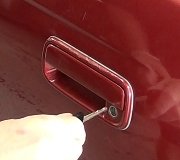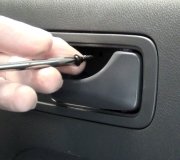Hello,
Here is some testing to do
These tests are for Vehicle with Anti-Theft System
1. Turn ignition off. Remove and inspect fuse No. 25 (20-amp) from central junction box. Central junction box is located under left side of steering column. If fuse is okay, go to next step. If fuse is blown, replace fuse and retest system operation. If fuse fails again, check for short to ground in suspect circuit. See WIRING DIAGRAMS. Repair as necessary and retest system operation.
2. Disconnect central locking module 13-pin connector C451b (located in right side "A" pillar). Using a voltmeter, check voltage between ground and central locking module 13-pin harness connector C451b terminal No. 1 (Orange/White wire). See Fig. 1. If voltage is more than 10 volts, go to next step. If voltage is 10 volts or less, repair Orange/White wire and retest system operation.
3. Press door lock switch to lock position. Check voltage between ground and central locking module 13-pin harness connector C451b terminal No. 10 (Yellow/Violet wire) while pressing door unlock switch. If voltage is more than 10 volts, go to next step. If voltage is 10 volts or less, repair Yellow/Violet wire and retest system operation.
4. Press door lock switch to unlock position. Check voltage between ground and central locking module 13-pin harness connector C451b terminal No. 3 (White/Violet wire) while pressing door lock switch. If voltage is more than 10 volts, replace central locking module and retest system operation. If voltage is 10 volts or less, repair White/Violet wire and retest system operation.
These are for Systems Without Anti-Theft System
1. Turn ignition off. Remove and inspect fuse No. 25 (20-amp) from central junction box. Central junction box is located under left side of steering column. If fuse is okay, go to next step. If fuse is blown, replace fuse and retest system operation. If fuse fails again, check for short to ground in suspect circuit. See WIRING DIAGRAMS. Repair as necessary and retest system operation.
2. Remove door lock relay (located in right side "A" pillar). Using a voltmeter, check voltage between ground and door lock relay harness connector C1911 terminal No. 3 (Orange/Blue wire). See Fig. 2. If voltage is more than 10 volts, go to next step. If voltage is 10 volts or less, repair Orange/Blue wire and retest system operation.
3. Using an ohmmeter, check resistance between ground and door lock relay harness connector C1911 terminal No. 2 (Black wire). See Fig. 2. If resistance is less than 5 ohms, go to next step. If resistance is 5 ohms or more, repair open in Black wire between door lock relay and ground connector located at right "A" pillar. Retest system operation.
4. Press door lock switch to lock position. Check voltage between ground and door lock relay harness connector C1911 terminal No. 1 (Yellow/Red wire) while pressing door unlock switch. If voltage is more than 10 volts, go to next step. If voltage is 10 volts or less, repair Yellow/Red wire and retest system operation.
5. Press door lock switch to unlock position. Check voltage between ground and door lock relay harness connector C1911 terminal No. 5 (White/Red wire) while pressing door lock switch. If voltage is more than 10 volts, replace door lock relay and retest system operation. If voltage is 10 volts or less, repair White/Red wire and retest system operation.
.
Monday, June 7th, 2010 AT 3:15 PM


